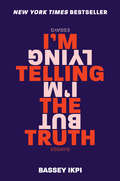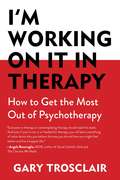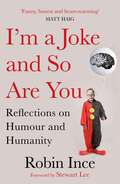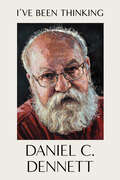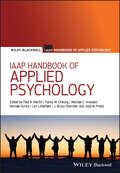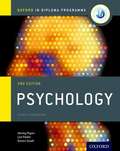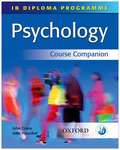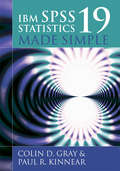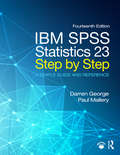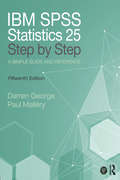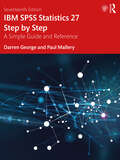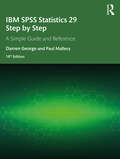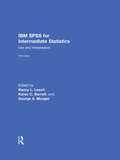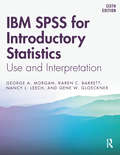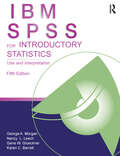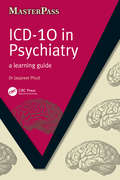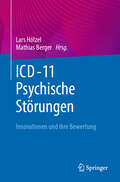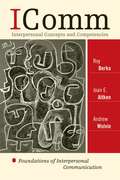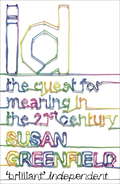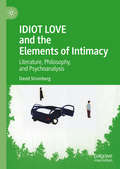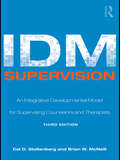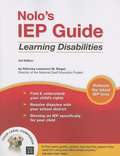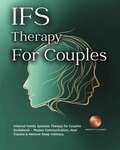- Table View
- List View
I'm Telling the Truth, but I'm Lying: Essays
by Bassey IkpiIn I’m Telling the Truth, but I’m Lying Bassey Bassey Ikpi explores her life—as a Nigerian-American immigrant, a black woman, a slam poet, a mother, a daughter, an artist—through the lens of her mental health and diagnosis of bipolar II and anxiety. Her remarkable memoir in essays implodes our preconceptions of the mind and normalcy as Bassey bares her own truths and lies for us all to behold with radical honesty and brutal intimacy. <P><P>From her early childhood in Nigeria through her adolescence in Oklahoma, Bassey Ikpi lived with a tumult of emotions, cycling between extreme euphoria and deep depression—sometimes within the course of a single day. By the time she was in her early twenties, Bassey was a spoken word artist and traveling with HBO's Def Poetry Jam, channeling her life into art. <P><P>But beneath the façade of the confident performer, Bassey's mental health was in a precipitous decline, culminating in a breakdown that resulted in hospitalization and a diagnosis of Bipolar II. <P><P>In I'm Telling the Truth, But I'm Lying, Bassey Ikpi breaks open our understanding of mental health by giving us intimate access to her own. Exploring shame, confusion, medication, and family in the process, Bassey looks at how mental health impacts every aspect of our lives—how we appear to others, and more importantly to ourselves—and challenges our preconception about what it means to be "normal." <P><P>Viscerally raw and honest, the result is an exploration of the stories we tell ourselves to make sense of who we are—and the ways, as honest as we try to be, each of these stories can also be a lie.
I'm Working On It in Therapy: How to Get the Most Out of Psychotherapy
by Gary TrosclairLearn to get the most out of therapy to unlock your best self. Learn to get the most out of therapy to unlock your best self. Millions of Americans will go to therapy this year, but veteran psychotherapist Gary Trosclair believes the vast majority of them will start the process with little to no sense of how to best use their sessions to achieve their goals. Recent research has identified effective client participation as one of the most crucial factors in successful therapy. What can one do to get the most out of their sessions to create lasting positive changes in their lives? What does it look like to "work on it” in therapy? Trosclair covers these points and more, combining cutting-edge scientific research with years of fascinating anecdotal evidence to create a guide that is as compelling as it is indispensable. It teaches readers how to take off their masks and be real with their therapists, how to deal with emotions that arise in session, how to continue their psychological work outside of sessions, how to know when it’s time to say goodbye to their therapists, and much more. Whether you’re already in therapy and looking to make more out of each appointment, or you’re thinking of starting the process and want to go in with a game plan, I’m Working on It in Therapy will show you how you can make every session count towards becoming your best possible self.
I'm a Joke and So Are You: Reflections on Humour and Humanity
by Robin InceEvening Standard's the Best Comedy Books of the Year, 2018Skinny's Book of the Year, 2018'Joyfully entertaining. Full of warmth, wisdom and affectionate delight in the wonder and absurdity of being human.' Observer'Funny, honest and heart-warming.' Matt HaigWhat better way to understand ourselves than through the eyes of comedians - those who professionally examine our quirks on stage daily? In this touching and witty book, award-winning presenter and comic Robin Ince uses the life of the stand-up as a way of exploring some of the biggest questions we all face. Where does anxiety come from? How do we overcome imposter syndrome? What is the key to creativity? How can we deal with grief?Informed by personal insights from Robin as well as interviews with some of the world's top comedians, neuroscientists and psychologists, this is a hilarious and often moving primer to the mind. But it is also a powerful call to embrace the full breadth of our inner experience - no matter how strange we worry it may be!
I've Been Thinking
by Daniel C. Dennett"How unfair for one man to be blessed with such a torrent of stimulating thoughts. Stimulating is an understatement." —Richard Dawkins A memoir by one of the greatest minds of our age, preeminent philosopher and cognitive scientist Daniel C. Dennett. Daniel C. Dennett, preeminent philosopher and cognitive scientist, has spent his career considering the thorniest, most fundamental mysteries of the mind. Do we have free will? What is consciousness and how did it come about? What distinguishes human minds from the minds of animals? Dennett’s answers have profoundly shaped our age of philosophical thought. In I’ve Been Thinking, he reflects on his amazing career and lifelong scientific fascinations. Dennett’s relentless curiosity has taken him from a childhood in Beirut and the classrooms of Harvard, Oxford, and Tufts, to “Cognitive Cruises” on sailboats and the fields and orchards of Maine, and to laboratories and think tanks around the world. Along the way, I’ve Been Thinking provides a master class in the dominant themes of twentieth-century philosophy and cognitive science—including language, evolution, logic, religion, and AI—and reveals both the mistakes and breakthroughs that shaped Dennett’s theories. Key to this journey are Dennett’s interlocutors—Douglas Hofstadter, Marvin Minsky, Willard Van Orman Quine, Gilbert Ryle, Richard Rorty, Thomas Nagel, John Searle, Gerald Edelman, Stephen Jay Gould, Jerry Fodor, Rodney Brooks, and more—whose ideas, even when he disagreed with them, helped to form his convictions about the mind and consciousness. Studded with photographs and told with characteristic warmth, I’ve Been Thinking also instills the value of life beyond the university, one enriched by sculpture, music, farming, and deep connection to family. Dennett compels us to consider: What do I really think? And what if I’m wrong? This memoir by one of the greatest minds of our time will speak to anyone who seeks to balance a life of the mind with adventure and creativity.
IAAP Handbook of Applied Psychology (Blackwell Iaap Handbooks Of Applied Psychology Ser. #1)
by Paul R. Martin Fanny M. Cheung J. Bruce Overmier Michael Kyrios Michael C. Knowles Lyn Littlefield Jos M. PrietoThe IAAP Handbook of Applied Psychology, an up-to-date and authoritative reference, provides a critical overview of applied psychology from an international perspective. Brings together articles by leading authorities from around the world Provides the reader with a complete overview of the field and highlights key research findings Divided into three parts: professional psychology, substantive areas of applied psychology, and special topics in applied psychology Explores the challenges, opportunities, and potential future developments in applied psychology Features comprehensive coverage of the field, including topics as diverse as clinical health psychology, environmental psychology, and consumer psychology
IB Psychology Course Book: Oxford IB Diploma Programme
by Lee Parker Alexey Popov Darren SeathComprehensively updated for the latest syllabus, for first teaching September 2017, and developed directly with the IB, the second edition of this popular Psychology Course Book provides thorough coverage of all core and optional units at Standard and Higher Level, as well as assessment preparation support. Engaging, full-colour activities and in-depth, international case studies bring the theory to life, while structured opportunities for critical thinking and concept-based learning help to develop enquiring and independent learners. Clear and accessible language, a robust reference section, support for the Internal Assessment and TOK links ensure that all learners progress through the DP Psychology course with confidence.
IB Psychology Course Companion: International Baccalaureate Diploma Programme
by John Crane Jette HannibalDeveloped in collaboration with the International Baccalaureate Organization, Oxford's Course Companions provide extra support for students taking IB Diploma Programme courses. They present a whole-course approach with a wide range of resources, and encourage a deep understanding of each subject by making connections to wider issues and providing opportunities for critical thinking. With coverage of the 2007 course outline, this course companion has been written by a principal examiner for IB Diploma Psychology and has been extensively reviewed by teachers, consultants and the IBO. The book contains a unique approach, integrating theory of knowledge and internationalism throughout. Lively and accessible, activities and features are provided for learning and discussion around core and wider issues, and include much needed guidance on study and writing skills. Also included are exam and Extended Essay advice.
IBM SPSS Statistics 19 Made Simple
by Paul R. Kinnear Colin D. GrayThis new edition of one of the most widely read textbooks in its field introduces the reader to data analysis with the most powerful and versatile statistical package on the market: IBM SPSS Statistics 19. Each new release of SPSS Statistics features new options and other improvements. There remains a core of fundamental operating principles and techniques which have continued to apply to all releases issued in recent years and have been proved to be worth communicating in a small volume. This practical and informal book combines simplicity and clarity of presentation with a comprehensive treatment of the use of IBM SPSS Statistics 19 for the description, exploration and confirmation of data. As in earlier editions, coverage has been extended to address the issues raised by readers since the previous edition. In this edition, there is an introduction to the Analysis of Covariance (ANCOVA). Each statistical technique is presented in a realistic research context and is fully illustrated with annotated screen shots of SPSS dialog boxes and output. The first chapter sets the scene with a survey of typical research situations, key terms and clear signposts to the location of each technique in the book. It also offers guidance on the choice of statistical techniques, and advice (based on the American Psychological Association’s guidelines) on how to report the results of a statistical analysis. The next chapters introduce the reader to the use of SPSS, beginning with the entry, description and exploration of data. There is also a full description of the capabilities of the versatile Chart Builder. Each of the remaining chapters concentrates on one particular kind of research situation and the statistical techniques that are appropriate. In summary, IBM SPSS Statistics 19 Made Simple Gets you started with SPSS. Shows you how to describe and explore a data set with the help of SPSS’s extensive graphics and data-handling menus. Helps you to choose appropriate statistical techniques. Warns you of pitfalls arising from the misuse of statistics. Shows you how to report the results of a statistical analysis. Shows you how to use Syntax to implement some useful procedures and operations. Introduces the reader to the analysis of covariance (ANCOVA) Has a comprehensive glossary. Is now presented in an attractive two-colour format. The book’s accompanying website contains datasets for the chapters of the book, as well as a large body of exercises (with data sets), and notes on statistical terms. Instructor resources include a PowerPoint lecture course and Multiple-Choice Question tests, which are also available free of charge to lecturers adopting the book and their students. Please visit http://www.psypress.com/spss-made-simple for more details.
IBM SPSS Statistics 23 Step by Step: A Simple Guide and Reference (14th Edition)
by Darren George Paul MalleryIBM SPSS Statistics 23 Step by Step: A Simple Guide and Reference, 14e, takes a straightforward, step-by-step approach that makes SPSS software clear to beginners and experienced researchers alike. Extensive use of vivid, four-color screen shots, clear writing, and step-by-step boxes guide readers through the program. Exercises at the end of each chapter support students by providing additional opportunities to practice using SPSS. All datasets used in the book are available for download at: https://www.routledge.com/products/ 9780134320250
IBM SPSS Statistics 25 Step by Step: A Simple Guide and Reference
by Darren George Paul MalleryIBM SPSS Statistics 25 Step by Step: A Simple Guide and Reference, fifteenth edition, takes a straightforward, step-by-step approach that makes SPSS software clear to beginners and experienced researchers alike. Extensive use of four-color screen shots, clear writing, and step-by-step boxes guide readers through the program. Exercises at the end of each chapter support students by providing additional opportunities to practice using SPSS. This book covers both the basics of descriptive statistical analysis using SPSS through to more advanced topics such as multiple regression, multidimensional scaling and MANOVA, including instructions for Windows and Mac. This makes it ideal for both undergraduate statistics courses and for postgraduates looking to further develop their statistics and SPSS knowledge. New to this edition: Updated throughout to SPSS 25 Updated / restructured material on: Chart Builder; Univariate ANOVA; moderation on two- and three-way ANOVA; and Factor Analytic Techniques (formerly Factor Analysis structure) New material on computing z and T scores, and on computing z scores within descriptive statistics Clearer in-chapter links between the type of data and type of research question that the procedure can answer Updated / additional datasets, exercises, and expanded Companion Website material, including Powerpoint slides for instructors
IBM SPSS Statistics 26 Step by Step: A Simple Guide and Reference
by Darren George Paul MalleryIBM SPSS Statistics 26 Step by Step: A Simple Guide and Reference, sixteenth edition, takes a straightforward, step-by-step approach that makes SPSS software clear to beginners and experienced researchers alike. Extensive use of four-color screen shots, clear writing, and step-by-step boxes guide readers through the program. Output for each procedure is explained and illustrated, and every output term is defined. Exercises at the end of each chapter support students by providing additional opportunities to practice using SPSS. This book covers the basics of statistical analysis and addresses more advanced topics such as multi-dimensional scaling, factor analysis, discriminant analysis, measures of internal consistency, MANOVA (between- and within-subjects), cluster analysis, Log-linear models, logistic regression and a chapter describing residuals. Back matter includes a description of data files used in exercises, an exhaustive glossary, suggestions for further reading and a comprehensive index. IMB SPSS Statistics 26 Step by Step is distributed in 85 countries, has been an academic best seller through most of the earlier editions, and has proved invaluable aid to thousands of researchers and students. New to this edition: Screenshots, explanations, and step-by-step boxes have been fully updated to reflect SPSS 26 How to handle missing data has been revised and expanded and now includes a detailed explanation of how to create regression equations to replace missing data More explicit coverage of how to report APA style statistics; this primarily shows up in the Output sections of Chapters 6 through 16, though changes have been made throughout the text.
IBM SPSS Statistics 27 Step by Step: A Simple Guide and Reference
by Darren George Paul MalleryIBM SPSS Statistics 27 Step by Step: A Simple Guide and Reference, seventeenth edition, takes a straightforward, step-by-step approach that makes SPSS software clear to beginners and experienced researchers alike. Extensive use of four-color screen shots, clear writing, and step-by-step boxes guide readers through the program. Output for each procedure is explained and illustrated, and every output term is defined. Exercises at the end of each chapter support students by providing additional opportunities to practice using SPSS. This book covers the basics of statistical analysis and addresses more advanced topics such as multidimensional scaling, factor analysis, discriminant analysis, measures of internal consistency, MANOVA (between- and within-subjects), cluster analysis, Log-linear models, logistic regression, and a chapter describing residuals. The end sections include a description of data files used in exercises, an exhaustive glossary, suggestions for further reading, and a comprehensive index. IBM SPSS Statistics 27 Step by Step is distributed in 85 countries, has been an academic best seller through most of the earlier editions, and has proved an invaluable aid to thousands of researchers and students. New to this edition: Screenshots, explanations, and step-by-step boxes have been fully updated to reflect SPSS 27 A new chapter on a priori power analysis helps researchers determine the sample size needed for their research before starting data collection.
IBM SPSS Statistics 29 Step by Step: A Simple Guide and Reference
by Darren George Paul MalleryIBM SPSS Statistics 29 Step by Step: A Simple Guide and Reference, eighteenth edition, takes a straightforward, step-by-step approach that makes SPSS software clear to beginners and experienced researchers alike.Extensive use of four-color screen shots, clear writing, and step-by-step boxes guide readers through the program. Output for each procedure is explained and illustrated, and every output term is defined. Exercises at the end of each chapter support students by providing additional opportunities to practice using SPSS. This book covers the basics of statistical analysis and addresses more advanced topics such as multidimensional scaling, factor analysis, discriminant analysis, measures of internal consistency, MANOVA (between- and within-subjects), cluster analysis, Log-linear models, logistic regression, and a chapter describing residuals. New to this edition is a new chapter on meta-analysis that describes new SPSS procedures for analyzing effect sizes across studies, and the content has been thoroughly updated in line with the latest version of the SPSS software, SPSS 29. The end sections include a description of data files used in exercises, an exhaustive glossary, suggestions for further reading, and a comprehensive index.Accompanied by updated online instructor’s materials and website data files, this is an essential resource for instructors and students needing a guide to using SPSS in their work, across the social sciences, behavioural sciences, education, and beyond.
IBM SPSS for Intermediate Statistics: Use and Interpretation, Fifth Edition
by George A. Morgan Nancy L. Leech Karen C. BarrettDesigned to help readers analyze and interpret research data using IBM SPSS, this user-friendly book shows readers how to choose the appropriate statistic based on the design; perform intermediate statistics, including multivariate statistics; interpret output; and write about the results. The book reviews research designs and how to assess the accuracy and reliability of data; how to determine whether data meet the assumptions of statistical tests; how to calculate and interpret effect sizes for intermediate statistics, including odds ratios for logistic analysis; how to compute and interpret post-hoc power; and an overview of basic statistics for those who need a review. Unique chapters on multilevel linear modeling; multivariate analysis of variance (MANOVA); assessing reliability of data; multiple imputation; mediation, moderation, and canonical correlation; and factor analysis are provided. SPSS syntax with output is included for those who prefer this format. The new edition features: * IBM SPSS version 22; although the book can be used with most older and newer versions * New discusiion of intraclass correlations (Ch. 3) * Expanded discussion of effect sizes that includes confidence intervals of effect sizes (ch.5) * New information on part and partial correlations and how they are interpreted and a new discussion on backward elimination, another useful multiple regression method (Ch. 6) * New chapter on how to use a variable as a mediator or a moderator (ch. 7) * Revised chapter on multilevel and hierarchical linear modeling (ch. 12) * A new chapter (ch. 13) on multiple imputation that demonstrates how to deal with missing data * Updated web resources for instructors including PowerPoint slides and answers to interpretation questions and extra problems and for students, data sets, chapter outlines, and study guides. IBM SPSS for Intermediate Statistics, Fifth Edition provides helpful teaching tools: * all of the key SPSS windows needed to perform the analyses * outputs with call-out boxes to highlight key points * interpretation sections and questions to help students better understand and interpret the output * extra problems with realistic data sets for practice using intermediate statistics * Appendices on how to get started with SPSS, write research questions, and basic statistics. An ideal supplement for courses in either intermediate/advanced statistics or research methods taught in departments of psychology, education, and other social, behavioral, and health sciences. This book is also appreciated by researchers in these areas looking for a handy reference for SPSS
IBM SPSS for Introductory Statistics: Use and Interpretation
by George A. Morgan Nancy L. Leech Karen C. Barrett Gene W. GloecknerIBM SPSS for Introductory Statistics is designed to help students learn how to analyze and interpret research. In easy-to-understand language, the authors show readers how to choose the appropriate statistic based on the design, and to interpret outputs appropriately. There is such a wide variety of options and statistics in SPSS, that knowing which ones to use and how to interpret the outputs can be difficult. This book assists students with these challenges. Comprehensive and user-friendly, the book prepares readers for each step in the research process: design, entering and checking data, testing assumptions, assessing reliability and validity, computing descriptive and inferential parametric and nonparametric statistics, and writing about results. Dialog windows and SPSS syntax, along with the output, are provided. Several realistic data sets, available online, are used to solve the chapter problems. This new edition includes updated screenshots and instructions for IBM SPSS 25, as well as updated pedagogy, such as callout boxes for each chapter indicating crucial elements of APA style and referencing outputs. IBM SPSS for Introductory Statistics is an invaluable supplemental (or lab text) book for students. In addition, this book and its companion, IBM SPSS for Intermediate Statistics, are useful as guides/reminders to faculty and professionals regarding the specific steps to take to use SPSS and/or how to use and interpret parts of SPSS with which they are unfamiliar.
IBM SPSS for Introductory Statistics: Use and Interpretation, Fifth Edition
by George A. Morgan Nancy L. Leech Karen C. Barrett Gene W. GloecknerDesigned to help students analyze and interpret research data using IBM SPSS, this user-friendly book, written in easy-to-understand language, shows readers how to choose the appropriate statistic based on the design, and to interpret outputs appropriately. The authors prepare readers for all of the steps in the research process: design, entering and checking data, testing assumptions, assessing reliability and validity, computing descriptive and inferential parametric and nonparametric statistics, and writing about outputs. Dialog windows and SPSS syntax, along with the output, are provided. Three realistic data sets, available on the Internet, are used to solve the chapter problems. The new edition features: Updated to IBM SPSS version 20 but the book can also be used with older and newer versions of SPSS. A new chapter (7) including an introduction to Cronbach’s alpha and factor analysis. Updated Web Resources with PowerPoint slides, additional activities/suggestions, and the answers to even-numbered interpretation questions for the instructors, and chapter study guides and outlines and extra SPSS problems for the students. The web resource is located www.routledge.com/9781848729827 . Students, instructors, and individual purchasers can access the data files to accompany the book at www.routledge.com/9781848729827 . IBM SPSS for Introductory Statistics, Fifth Edition provides helpful teaching tools: All of the key IBM SPSS windows needed to perform the analyses. Complete outputs with call-out boxes to highlight key points. Flowcharts and tables to help select appropriate statistics and interpret effect sizes. Interpretation sections and questions help students better understand and interpret the output. Assignments organized the way students proceed when they conduct a research project. Examples of how to write about outputs and make tables in APA format. Helpful appendices on how to get started with SPSS and write research questions. An ideal supplement for courses in either statistics, research methods, or any course in which SPSS is used, such as in departments of psychology, education, and other social and health sciences. This book is also appreciated by researchers interested in using SPSS for their data analysis.
ICD 10 in Psychiatry: A Learning Guide
by Jaspreet PhullCore to psychiatry is the practice of assessment, diagnosis and management. All three elements are subject to identifying the correct diagnosis and all three influence the clinical management of individuals with a mental disorder. This easy-to-comprehend, list-based book presents mnemonics to aid immediate recall of the International Classification of Diseases and Related Health Problems (ICD 10) for prompt diagnosis in psychiatry. Used in conjunction with other ICD 10 guides, this remarkable resource is ideal for memorising the myriad complexities of the ICD 10 for anyone with an interest in learning about diagnostic coding in psychiatry including medical students, psychiatry trainees and mental health professionals. During my time revising for my psychiatry postgraduate examinations, I found learning of ICD 10 for diagnosis particularly testing, especially given the depth and complexity of the criteria. I found aide memoires in the form of mnemonics particularly helpful to support my learning of the subject, allowing for much more efficient recall. From the Preface
ICD-11 – Psychische Störungen: Innovationen und ihre Bewertung
by Mathias Berger Lars HölzelDas Buch ist eine Einführung in und ein Überblick über das komplexe Gebilde der ICD-11 für psychische und psychosomatische Erkrankungen. Die Herausgeber und Autoren stellen in dem kompakten und gut lesbaren Werk die ICD-11 insbesondere im Hinblick auf die Veränderungen zu ICD-10 dar. Besonderen Wert legen sie auf eine Bewertung der Neuerungen aus wissenschaftlicher und klinischer Sicht sowie deren Implikationen für die zukünftige klinische Arbeit.
ICOMM - Interpersonal Concepts and Competencies: Foundations of Interpersonal Communication
by Andrew Wolvin Roy Berko Joan E. AitkenICOMM: Interpersonal Concepts and Competencies, provides an integrated approach to the study of interpersonal communication. This accessibly written but authoritative text emphasizes the development of communication competencies, including skills, understanding of the theory and research that contextualizes the skills to make them relevant to learning, and the motivation to put the skills into practice. While incorporating many traditional intrapersonal and interpersonal topics found in current texts, the book is distinctive in that it offers a skills-based approach that is grounded in solid theory and research. Students will find that the text is written in a personal and friendly manner, stressing concepts, skills, and applications that should be an important part of their daily lives.
ID
by Susan GreenfieldIf you’ve ever wondered what effect video games have on your children’s minds or worried about how much private information the government and big companies know about you, ID is essential reading.Professor Susan Greenfield argues persuasively that our individuality is under the microscope as never before; now more then ever we urgently need to look at what we want for ourselves as individuals and for our future society.ID is an exploration of what it means to be human in a world of rapid change, a passionately argued wake-up call and an inspiring challenge to embrace creativity and forge our own identities.
ID
by Susan GreenfieldIf you?ve ever wondered what effect video games have on your children?s minds or worried about how much private information the government and big companies know about you, ID is essential reading.Professor Susan Greenfield argues persuasively that our individuality is under the microscope as never before; now more then ever we urgently need to look at what we want for ourselves as individuals and for our future society.ID is an exploration of what it means to be human in a world of rapid change, a passionately argued wake-up call and an inspiring challenge to embrace creativity and forge our own identities.
IDIOT LOVE and the Elements of Intimacy: Literature, Philosophy, and Psychoanalysis
by David StrombergThis book turns our search for intimacy on its head, suggesting that our way to creativity in love may be through idiocy. The book takes its readers on a journey through the work of Plato and Melanie Klein in theorizing the dynamics of intimacy while exploring some of the paradoxical aspects of love in works by Fyodor Dostoevsky and French filmmaker Catherine Breillat. Revisiting core concepts of how we think about relationships, the book lays out a model for relational breakdown—the idiot lovecycle—in which we are constantly in the flux between seeing ourselves and seeing the other. Effecting close readings of literary, philosophical, and psychoanalytical sources, the book draws on parallels between these fields of inquiry while tracing their shared intellectual genealogy, suggesting that the tension between Narcissus and Cassandra, with its inherent conflicts, is also the space through which love emerges from intimacy.
IDM Supervision: An Integrative Developmental Model for Supervising Counselors and Therapists, Third Edition (Counseling and Psychotherapy)
by Cal D. Stoltenberg Brian W. McNeillThe third edition of this book is an updated and expanded presentation of the widely used Integrative Developmental Model of Supervision. In contrast to other volumes on clinical supervision, Stoltenberg and McNeill present a comprehensive, time-tested, and empirically investigated model of supervision, rather than a broad summary of other existing or historical approaches. In addition to presenting a model of therapist development that spans beginning through advanced training, the book integrates theory and research from numerous perspectives, including learning, cognition, and emotion, as well as an up-to-date treatment of research directly addressing the supervision process. The model also examines the role of clinical supervision from an evidence-based practice perspective and addresses issues of common factors in therapy. The impact of cultural issues in supervision and training, as well as recent work in a competencies approach to supervision and trainee development, are also examined.
IEP Guide: Learning Disabilities
by Lawrence SiegelUsing plain language, Siegel, a special education attorney, explains assessments, goals and objectives, eligibility requirements, and other IEP issues in this resource for parents of children with learning disabilities. He walks through the entire IEP process, providing instructions, checklists, sample forms and letters, and numerous suggestions for specific actions to take. He gives advice on finding and understanding information on a child's rights, and tells how to prepare for IEP meetings and how to resolve disputes with the school district. Appendices list relevant laws and regulations, federal and state departments of education, and support and advocacy groups. Annotation ©2004 Book News, Inc., Portland, OR (booknews.com)
IFS Therapy for Couples: Internal Family Systems Therapy for Couples Guidebook - Master Communication, Heal Trauma & Restore Deep Intimacy
by Jessica FilipowskiIFS THERAPY FOR COUPLES: TRANSFORM YOUR RELATIONSHIP WITH INTERNAL FAMILY SYSTEMS Discover how to break free from recurring relationship patterns and create lasting intimacy through Internal Family Systems therapy. This practical guidebook shows you how to understand the parts of you and your partner that shape your relationship dynamics. Learn to recognize protective patterns, heal attachment wounds, and build genuine connection using IFS tools that work. Inside, you'll find real examples from couples who have transformed their relationships, practical exercises you can start using today, and clear protocols for handling triggers, improving communication, and deepening trust. Whether you're struggling with communication, recovering from relationship trauma, or simply wanting to create a stronger bond, this book provides a clear path forward. Written in accessible language and grounded in real relationship scenarios, this guide helps you: - Transform communication patterns that keep you stuck - Build emotional safety and trust - Heal relationship wounds together - Create lasting intimacy and connection - Understand and work with your protective parts - Access natural Self leadership in your partnership Perfect for couples looking to create positive change, therapists seeking practical IFS relationship tools, and anyone interested in applying Internal Family Systems to strengthen their relationship.
